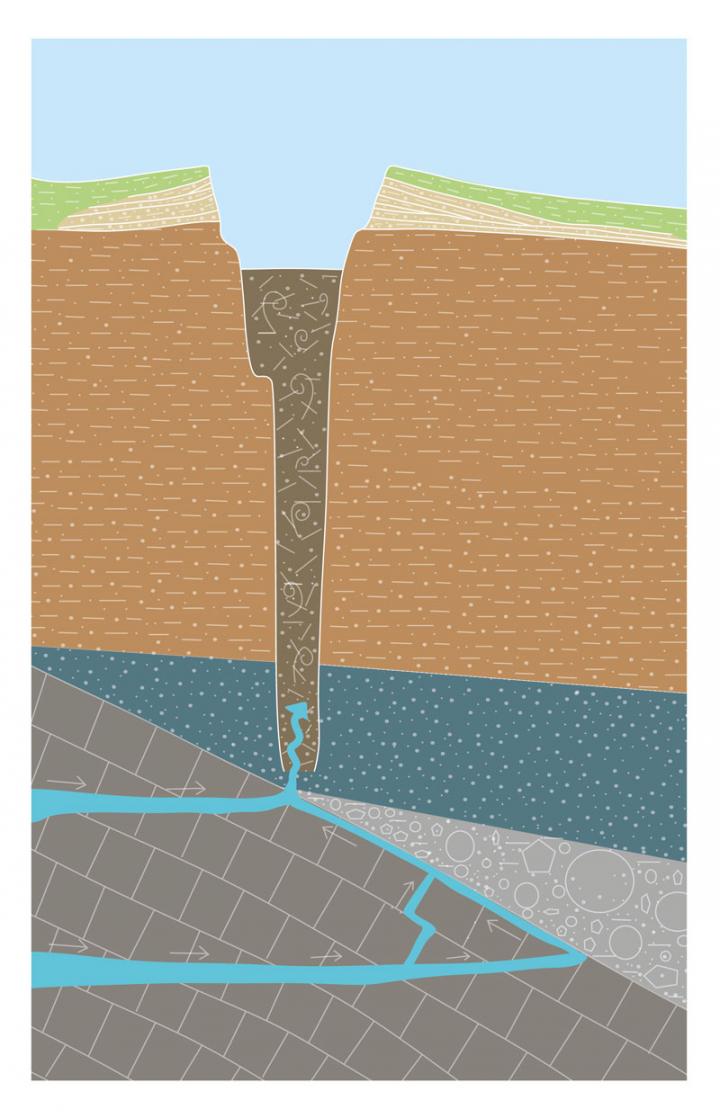Anna Reusch, a doctoral student at ETH Zurich's Geological Institute, was making a routine research vessel run on Lake Neuchâtel when she noticed an unusual shape on the control panel screen.
At a depth of over 100 mettrs, she found something no one had ever detected before: a crater measuring 10 meters deep and 160 meters in diameter.
Reusch investigates the sediment in the lakes on the western Swiss Plateau for traces of past earthquakes, which involves taking high-resolution measurements of the floor of Lake Neuchâtel to find evidence of tectonically active zones that could trigger major earthquakes. The period Reusch is looking at is geologically speaking very recent: sometime in the past 12,000 years.

The scheme of Crazy Crater. Credit: ETH Zurich / based on Reusch et al. 2015
Four lake craters
All in all, the research team located four craters on the lake bed. All are off the northwest shore at a depth of over 100 meters, with most of them in an area extending from known tectonic fault zones.
The craters measure 80 to 160 meters in diameter and between 5.5 and 30 meters in depth. Researchers nicknamed the largest of them "Crazy Crater", not just because of its uncommonly generous proportions, but also because of its unusual shape: whereas comparable structures on the ocean floor usually lose their shape through the action of currents, this one is perfectly round.
At the foot of the 10-meter-deep Crazy Crater, the researchers were able to make out a mud covering. Beneath it lies a 60-meter-deep vent, filled with a thick suspension of water and sediment. The team was unable to take core samples because the material was too fluid, due to water welling up into the vent from below. This keeps the sediments in the vent in motion, ensuring that they can't settle into a solid state as normal lake sediment does.
By measuring the isotope fingerprint plus the temperature of the water, suspension and sediment, the scientists were able to show that it was water flowing up into these craters as opposed to, say, gas. While the suspension had a temperature of 8.4 degrees Celsius, both the deep water and the sediment surrounding the crater measured just 5.8 degrees. This corresponds to the normal temperature of the water at that depth in these lakes. By contrast, the temperature of the suspension is comparable to that of the surface water in the bordering karst area.
The suspension inside the vent also contains a smaller proportion of the heavy oxygen-18 isotope than does the surrounding lake water. "The difference in these oxygen signals indicates that we're talking about two distinct bodies of water here," says Reusch.
Gigantic spring
For this reason, Reusch believes it is most likely that the craters are linked to the karst systems of the neighboring Jura Mountains. Water there seeps underground, flows beneath the bed of Lake Neuchâtel and seeks out the path of least resistance up to the surface. That takes the water up through sediment layers over several tens of metres thick that have been deposited on the lake bed over the millennia. "In other words, these craters are in fact springs," explains Reusch.
Furthermore, the researchers were able to use sediment core samples taken from the area directly surrounding the craters to show that the suspension spills over the lip of the crater from time to time, similar to a volcanic eruption. This has happened at least four times over the past 12,000 years - and yet despite today's active water flow, it has been more than 1,600 years since Crazy Crater discharged any sediment on the crater levee.
Exactly what triggers these eruptions still needs to be investigated.
Citation: Reusch A, Loher M, Bouffard D, Moernaut J, Hellmich F, Anselmetti FS, Bernasconi SM, Hilbe M, Kopf A, Lilley MD, Meinecke G, Strasser M: Giant lacustrine pockmarks with subaqueous groundwater discharge and subsurface sediment mobilization, Geophysical Research Letters, 13 May 2015. doi:10.1002/2015GL064179




Comments